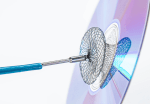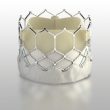Percutaneous coronary intervention (PCI) with drug coated balloons (DCB) is a viable alternative, especially in patients at high risk of bleeding, side-branch lesions in coronary bifurcation, or in small coronary segments. De novo heart disease treated with DCB has been shown non-inferior to conventional DES stenting, according to the PICCOLETO-II trial. However, these interventions are...
Biolimus vs Paclitaxel Coated Balloons for the Treatment of In-Stent Restenosis
Drug eluting stent (DES) in-stent restenosis (ISR) is currently a challenging, seeing as it often requires repeat revascularization. The use of drug coated balloons (DCB) offers the advantage of delivering the drug without the need for re-stenting. This highlights the importance of the technological development of DCB, with diverse drug formulations and coating technologies. As...
TENDER Study, Evolution at One Year
The use of transcatheter mitral valve intervention for the treatment of mitral valve regurgitation (MR) continues to evolve; at present guidelines only recommend it for inoperable or high surgical risk patients. So far, many devices have been assessed, some of which have shown promising results, but only for poor surgical candidates. Researchers looked into the...
Left Atrial Appendage Closure and Concomitant Transcatheter Intervention: Can We?
Several scientific societies support performing left atrial appendage occlusion (LAAO) as a stand-alone procedure, even though it is often associated to other cardiomyopathies requiring transcatheter intervention. Though still controversial, combining LAAO and any other cardiac intervention might reduce hospitalizations, as well as the need for additional punctures, anesthesia, red tape, a longer stay and higher...
Coronary Artery Disease in TAVR: Unsolved Dilemma
Aortic stenosis shares risk factors with coronary artery disease (CAD), and its prevalence varies according to age, reaching approximately 50% or more in some registries. Deciding when to treat and the need for percutaneous intervention presents a challenge. It has been established that epicardial stenosis at proximal level, or the medial segment, requires intervention, especially...
Relationship between Distal Vessel Quality and Outcomes in the Treatment of Chronic Total Occlusions
Percutaneous treatment of chronic total occlusions has increase, and has become a a more habitual therapeutic challenge. However, there is limited information on distal vessel quality and its association with outcomes and techniques. This variable appears to be excluded form CTO scores, except for the RECHARGE (REgistry of CrossBoss and Hybrid procedures in FrAnce, the...
EuroPCR 2022 | CLASP TR Study: Promising Results of Endovascular Intervention of Tricuspid Regurgitation
At present, we are well aware of the rise in mortality caused by severe tricuspid regurgitation (TR). Medical and surgical treatments have turned out to be suboptimal. Hence, endovascular intervention presents as an alternative therapeutic strategy with promising results. The aim of this multicenter, prospective study was to assess the safety and efficacy of the...
SOLACI-CACI 2021 | TCT II Session: Structural Heart Interventions
✔️ TCT Session in the SOLACI-CACI 2021 Congress. 👨🏫 Program: 02:44 – Future of TAVR – Martin B. Leon 36:27 – Future Developments in Trans-Catheter Mitral Valve Replacement – Juan F. Granada 01:02:53 – Interventional Heart Failure – Dan Burkhoff 👉🏻 Chairperson: Aníbal Damonte & Jorge Belardi 👉🏻 Digital Moderator: Matías Sztejman 👉🏻 Panelists:...
SOLACI-CACI 2021 | International Sessions with the Most Renowned Societies Worldwide
INTERNATIONAL SESSIONS WITH THE MOST RENOWNED SOCIETIES WORLDWIDE Appealing sessions on the most relevant current topics in interventional cardiology will be at the forefront of a virtual, interactive event you do not want to miss! Save the date: August 2-6, 2021 Register now for FREE Learn more about the international joint sessions featured in...
Sapien 3 Performs Well in “Jobs” for Which It Is Not Designed
Using Sapien 3, transcatheter mitral valve replacement to treat failed bioprosthetic valves can be performed with a high degree of technical success. Failed mitral bioprosthetic valves are truly challenging due to how frequent symptoms are and the high morbidity/mortality associated with a new surgical replacement. Furthermore, there are no catheter options specifically designed to treat this...









